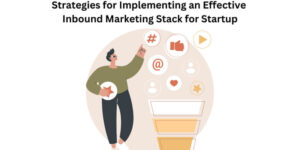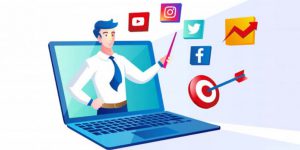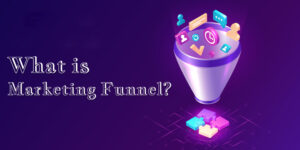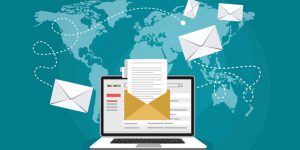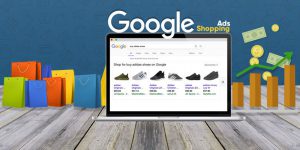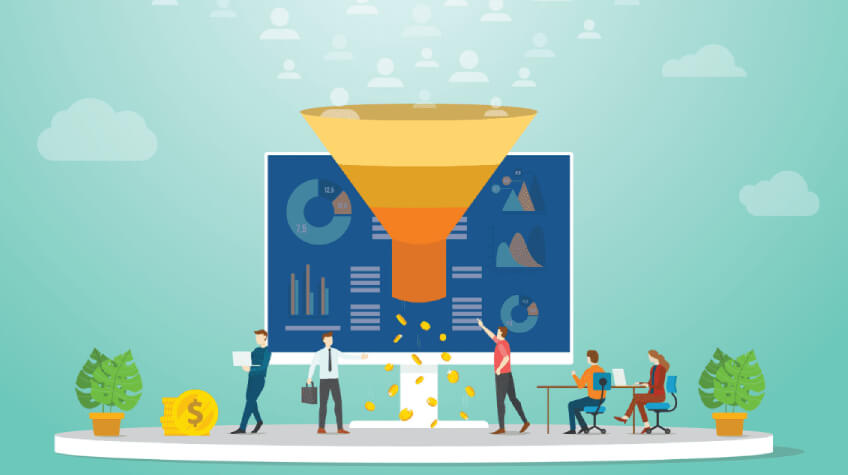
B2B eCommerce sales are increasing gradually but steadily. It is predicted to generate at least 13% of overall B2B revenue the following year. According to Accenture, when B2B consumers first contact a sales professional on their tablet devices in the evenings, they are already 57% of the way through the acquisition process.
To be effective, sales and marketing must adapt to the internet’s shifting purchase habits and incorporate a B2B sales funnel.
Creating a website and hoping for the best is a surefire formula for disaster. While business owners and senior executives are perplexed by poor digital channel performance, understanding your B2B sales funnel ensures that your marketing does not simply funnel leads into one silo. Your sales do not merely pitch their prospects into another.
In the long run, having a clear view of your B2B sales funnel may save your business considerable time and money.
A B2B sales funnel comprised of five phases
The first B2B sales funnel was built in 1898. At the top of the funnel, consumers are introduced to your brand, product, or service.
Things have altered dramatically in the decades afterward. You have a tiny window of opportunity to capture their attention right now. On average, it takes 37 seconds to read an article. Each phase of a B2B sales funnels model will be discussed in detail.
► The “Awareness stage” is the first stage in the sales funnel.
At the funnel’s awareness stage, a B2B customer is looking for answers. They require resources, expertise, data, perspectives, and insight to handle their issues. The issue might be as straightforward as locating a new supplier for their manufacturing needs or as complicated as connecting their front-end and back-end operations via software. Leads are worthless at the moment because there is no guarantee that they will purchase from your firm.
They could develop an interest if you provide them with sufficient high-level knowledge and substance. A persona is critical at the top of the funnel because it enables you to comprehend how your customers think, the problems they’re attempting to answer, and the path they take to get there.
► Level 2: This is the interest level in the sales funnel.
When a consumer reaches the inquiry stage, their interest in your products increases. At this point in the purchasing process, you begin to establish trust. At this stage, the purpose of lead nurturing is to improve the buyer’s perception of your firm.
► Evaluation is the third and last stage of the sales funnel.
The buyer’s attention has been firmly established at this point in the process. Once you’ve implemented your solution, you can concentrate on how it fits their needs. This is a fantastic chance to educate prospects if your answer does not fulfill their requirements, increasing their trust in you. Even if your product or service does not meet the buyer’s immediate needs, demonstrating your honesty and integrity today may pay off in the long run.
► The “engagement stage” is the fourth stage in the sales funnel.
After your lead reaches the Engagement level, your sales team will contact them. Demonstrations of products, sales presentations, and other methods of showing clients that you understand their issues and are willing to assist them in resolving them are all instances of this. The capacity of the lead to proceed to the next stage is strongly tied to the amount of connection and trust created thus far.
► Making a purchase decision is the sales funnel’s fifth and final stage.
This is the last step of a funnel in the conventional sense. The authorization has been obtained for the transaction, or a Purchase Order has been issued. However, just exchanging money and goods does not constitute the completion of the B2B sales funnel.
Post-purchase engagement is critical to the success of a B2B sales pipeline since it keeps clients happy and feeds the funnel. Due to the 30% higher conversion rate of referral leads over non-referral leads, 84 percent of B2B purchases begin with a reference from a friend or colleague.
On the other side, account-based marketing alters the funnel’s conventional purpose, which remains the most common B2B sales and marketing technique. Please check back for further information on this ground-breaking sales and marketing integration approach.
Related Post: How Does B2B Marketing Different From D2C
Numerous marketing strategies for the different stages of the funnel
As a consumer progresses through the marketing funnel, their requirements change. As a result, your marketing strategies and tactics will need to evolve. If you cannot convince people to purchase your stuff, you’re doing something wrong. Offers that are more appropriate for the Awareness stage take precedence over those more suitable for the Purchase stage. The buyer’s journey map is equally as critical for your marketing strategy and techniques as the buyer’s journey map.
During the periods of awareness and interest, potential purchasers may be ignorant of your presence. Individuals may not even be aware of what they desire or desire to compound problems.
First, they do online research to identify a remedy to their problem. Knowing who you are at this time in your life is more critical than ever. Your complete SEO, lead generation, and content marketing strategy should be directed towards your target audience. Utilize whitepapers that address common concerns, eBooks that give thorough information, and instructional videos to aid clients in resolving difficulties and gaining a better grasp of your company’s services.
Related: Role of Social Media Marketing in Integrated Marketing
Pay-per-click (PPC) advertising campaigns to generate leads may be a viable solution. Advertisements on Facebook Messenger and other social media platforms are highly efficient in acquiring new clients.
Individuals are encouraged to maintain their initial anonymity since they are not required to disclose their email addresses. As a result, if a lead opts in, you’ll have access to a lot of data about them that you would not have had previously. Effective Chatbot Messenger marketing requires concluding each discussion with a call to action.
Once you’ve piqued their interest, you must convince them that your answer is the best. Training your sales crew has never been easier. This will be your primary focus during the review and engagement stages. Share your personal success stories to illustrate how you’ve helped others in similar situations. Automating drip email marketing campaigns for your consumers is straightforward. According to a recent study, 75% of firms presently use automated marketing tactics.
Along with webinars, this process stage is great for question-and-answer sessions.
After your lead has progressed to the Purchase step, it is time to close the deal. Collaboration between marketing and sales is critical to closing a lead. Marketing should now give sales representatives case studies, product demos, and incentives. Marketers that aren’t quite ready to clinch the deal frequently provide incentives, case studies, and product demonstrations too early in the sales funnel. Offers presented at the end of the sales process, when the lead is most likely to purchase, will be more relevant.
Constructing a sales funnel for B2B transactions
A conventional funnel is divided into three sections: the top, the middle, and the bottom.
The Ascendant’s Ascendant’s Ascendant’s Ascendant (TOFU). This is the most critical segment of your marketing funnel since it contains both leads and prospects who have not yet contacted your firm. This phase is focused on selling your product. In other words, there is now no interest or demand for it. It is entirely up to you to think about either.
You stimulate your audience’s attention when you establish a connection with them. Once you’ve gotten them thus far down the funnel, you should maintain their position.
Potential buyers decide if your product or service is a suitable match for them in the Middle of the Pipe (MOFU).
These individuals may develop into qualified leads or those who have indicated an interest in your marketing efforts but are not yet ready to purchase. Sales-qualified leads are individuals who have demonstrated an interest in purchasing something and should be pursued with the intent of converting them to paying clients. These are prospects who have been pre-qualified for sales.
You’ve aided prospects in advancing to the bottom of the sales funnel, where they may assess whether your firm is the best fit for their requirements. They now have qualified leads who are much more than likely to purchase your goods or service. At this point, it’s pretty unlikely that they’ll purchase anything. It’s time to establish your worth and build trust to earn your business.
There are several types of sales funnels, and with enough research, you can recognize them all. According to several customer loyalty specialists, adding the fifth stage of customer enjoyment following the purchase and focusing on long-term, loyal relationships with your consumers is one example.
What is the difference between a marketing funnel and a sales funnel?
The terms “sales funnel” and “marketing funnel” are frequently used interchangeably due to their similar meanings. Historically, B2B sales were viewed as a linear process in which the buyer was introduced to the business through marketing activities. A marketing funnel’s purpose was to acquaint customers with the company’s brand and offerings. After customers were informed and prepared to assess a solution, the sales funnel continued the marketing funnel.
In conclusion
In today’s industry, the linear sales method is obsolete. Buyers are more knowledgeable than ever, which means they typically start the sales process having some knowledge about the firm and its products. As a result, differentiating marketing from sales became increasingly difficult.
When the corporate world adopted a new approach known as smarketing, marketing and sales teams partnered to ensure that the sales process finished in a closed agreement.

